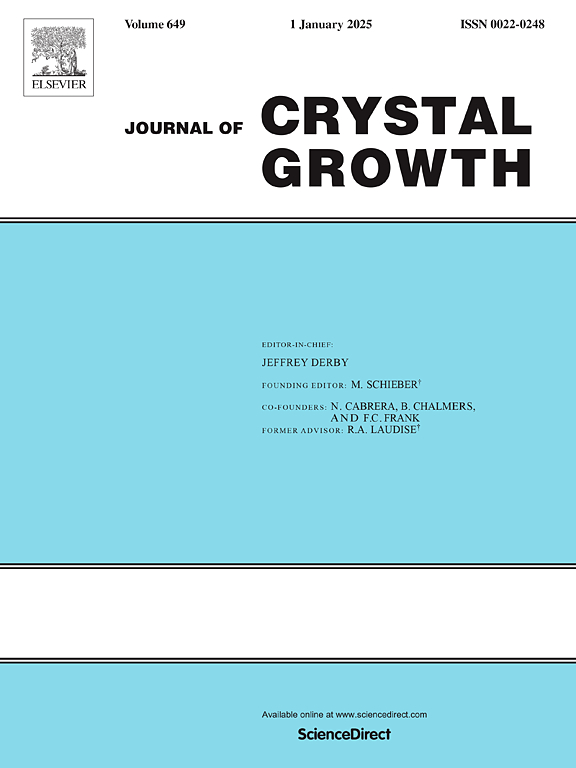Effect of UHV annealing on morphology and roughness of sputtered Si(1 1 1)-(7 × 7) surfaces
IF 1.7
4区 材料科学
Q3 CRYSTALLOGRAPHY
引用次数: 0
Abstract
Ar+ ion has been used regularly for the cleaning of semiconductor, metal surfaces for epitaxial nanostructures growth. We have investigated the effect of low-energy Ar+ ion sputtering and subsequent annealing on the Si(1 1 1)-(7 × 7) surfaces under ultrahigh vacuum (UHV) condition. Using in-situ scanning tunnelling microscopy (STM) we have compared the morphological changes to the Si(1 1 1)-(7 × 7) surfaces before and after the sputtering process. Following 500 eV Ar+ ion sputtering, the atomically flat Si(1 1 1)-(7 × 7) surface becomes amorphous. The average root mean square (rms) surface roughness () of the sputtered surface and that following post-annealing at different temperatures (500–700 °C) under UHV have been measured as a function of STM scan size. While, annealing at ∼500 °C shows no detectable changes in the surface morphology, recrystallization process starts at ∼600 °C. For the sputtered samples annealed at temperatures ≥600 °C, varies linearly at lower length scales and approaches a saturation value of ∼0.6 nm for the higher length scales confirming the self-affine fractal nature. The correlation length increases with annealing temperature indicating gradual improvement in crystallinity. For the present experimental conditions, 650 °C is the optimal annealing temperature for recrystallization. The results offer a method to engineer the crystallinity of sputtered surface during nanofabrication process.
超高压退火对溅射Si(11 11)-(7 × 7)表面形貌和粗糙度的影响
氩离子经常用于半导体、金属表面的清洁,以促进外延纳米结构的生长。在超高真空条件下,研究了低能氩离子溅射和后续退火对Si(11 11)-(7 × 7)表面的影响。利用原位扫描隧道显微镜(STM)比较了溅射前后Si(11 11)-(7 × 7)表面的形貌变化。在500 eV Ar+离子溅射后,原子平面的Si(11 11)-(7 × 7)表面变为非晶态。测量了溅射表面的平均均方根(rms)表面粗糙度(σavg)以及不同温度(500 ~ 700℃)特高压退火后的表面粗糙度与STM扫描尺寸的函数关系。而在~ 500°C退火时,表面形貌没有可检测到的变化,再结晶过程在~ 600°C开始。对于温度≥600°C退火的溅射样品,logσavg在较低的长度尺度上呈线性变化,在较高的长度尺度上接近0.6 nm的饱和值,证实了自仿射分形的性质。相关长度随退火温度的增加而增加,表明结晶度逐渐提高。在目前的实验条件下,650℃是再结晶的最佳退火温度。研究结果为纳米加工过程中溅射表面的结晶度设计提供了一种方法。
本文章由计算机程序翻译,如有差异,请以英文原文为准。
求助全文
约1分钟内获得全文
求助全文
来源期刊

Journal of Crystal Growth
化学-晶体学
CiteScore
3.60
自引率
11.10%
发文量
373
审稿时长
65 days
期刊介绍:
The journal offers a common reference and publication source for workers engaged in research on the experimental and theoretical aspects of crystal growth and its applications, e.g. in devices. Experimental and theoretical contributions are published in the following fields: theory of nucleation and growth, molecular kinetics and transport phenomena, crystallization in viscous media such as polymers and glasses; crystal growth of metals, minerals, semiconductors, superconductors, magnetics, inorganic, organic and biological substances in bulk or as thin films; molecular beam epitaxy, chemical vapor deposition, growth of III-V and II-VI and other semiconductors; characterization of single crystals by physical and chemical methods; apparatus, instrumentation and techniques for crystal growth, and purification methods; multilayer heterostructures and their characterisation with an emphasis on crystal growth and epitaxial aspects of electronic materials. A special feature of the journal is the periodic inclusion of proceedings of symposia and conferences on relevant aspects of crystal growth.
 求助内容:
求助内容: 应助结果提醒方式:
应助结果提醒方式:


